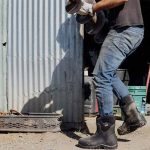The American Alpine Club, in partnership with more than a dozen supporting organizations, released its first-ever State of Climbing Report, a comprehensive quantitative look at the American climbing community and its impact. The report details the growth, size, and demographics of the current community, and attempts to apply a yardstick to the community’s conservation efforts, economic impact, climbing-related accidents, and political advocacy.
The rising influence of the sport of climbing in the United States is undeniable; in 2018 nearly 4.4 percent of all Americans climbed indoors, a documentary about climbing won an Academy Award, and data shows a bright future with millions of millennials taking up the sport. Data also shows that climbing is relatively homogenous in demographic makeup—the majority of participants being white and male.
American Alpine Club CEO Phil Powers spoke to the effort to quantify climbing in America today: “We believe that collecting and distributing this information can lead to inspired action among industry leaders and beyond. If our strengths are exhibited, we can leverage them. If our weaknesses are revealed, let’s address them.”
Economically, the 2019 State of Climbing Report demonstrates that the climbing community is a force. It’s estimated that the sport contributed an estimated $12,450,000,000 to the economy in 2017, with the vast majority (87 percent) coming from trip- and travel-related expenditures. Due to the often-remote nature of outdoor climbing, many communities that benefit from climbing-related travel are rural, and the sport has significant economic impact in places like Lee County, KY; Lander, WY; and Sandrock, AL.
The full State of Climbing report was made possible by the collaboration of multiple key partners, including the Access Fund, Climbing Wall Association, American Mountain Guides Association, USA Climbing, USA Ice Climbing, United States Ski Mountaineering Association, Outdoor Industry Association, The NPD Group, The Colorado Fourteeners Initiative, Brown Girls Climb, Latino Outdoors, Colorado Mountain Club, Joy Trip Project and Paradox Sports.
Download a free copy of the entire report:
americanalpineclub.org/state-of-climbing-report
2019 State of Climbing Report — Quick Facts
- In 2014, it was estimated that there were 7.7 million participants in climbing, up 6 percent over the previous year.
- 65 percent of all climbers are between the ages of 18 – 35 years old.
- As of 2018, 4.4 percent of all Americans climb indoors.
- Indoor climbers, or those who climb in gyms, make up 52 percent of the climbing population.
- Climbing as a whole contributed $12,450,000,000 to the economy in 2017.
- More than 25,000 watched the UIAA World Cup Ice Climbing Finals in Denver, CO in 2019, making it the largest live climbing competition in world history.
- 57 percent of climbing areas are located on federally managed lands.
- Climbers contributed more than 65,544 volunteer hours toward conservation and land stewardship efforts in 2018 through the Access Fund’s Adopt-a-Crag Program.
- More than 334,000 people climbed or hiked a Colorado “Fourteener” in 2017, up 6 percent year over year.
- 50 percent of all climbing-related accidents occurred from “falling or slipping” on either rock or ice.
- Across U.S. climbing gyms, there were just .007 reported incidents per 1000 visitor hours; when compared to a national average in CrossFit of 2.3 injuries per 1000 training hours, climbing gyms have an exceedingly low rate of injury.
- Beginning in 2019 ESPN will begin televised coverage of National Championship Climbing Competitions.
- Sport climbing is set to debut at the 2020 Summer Olympics in Tokyo, Japan.















